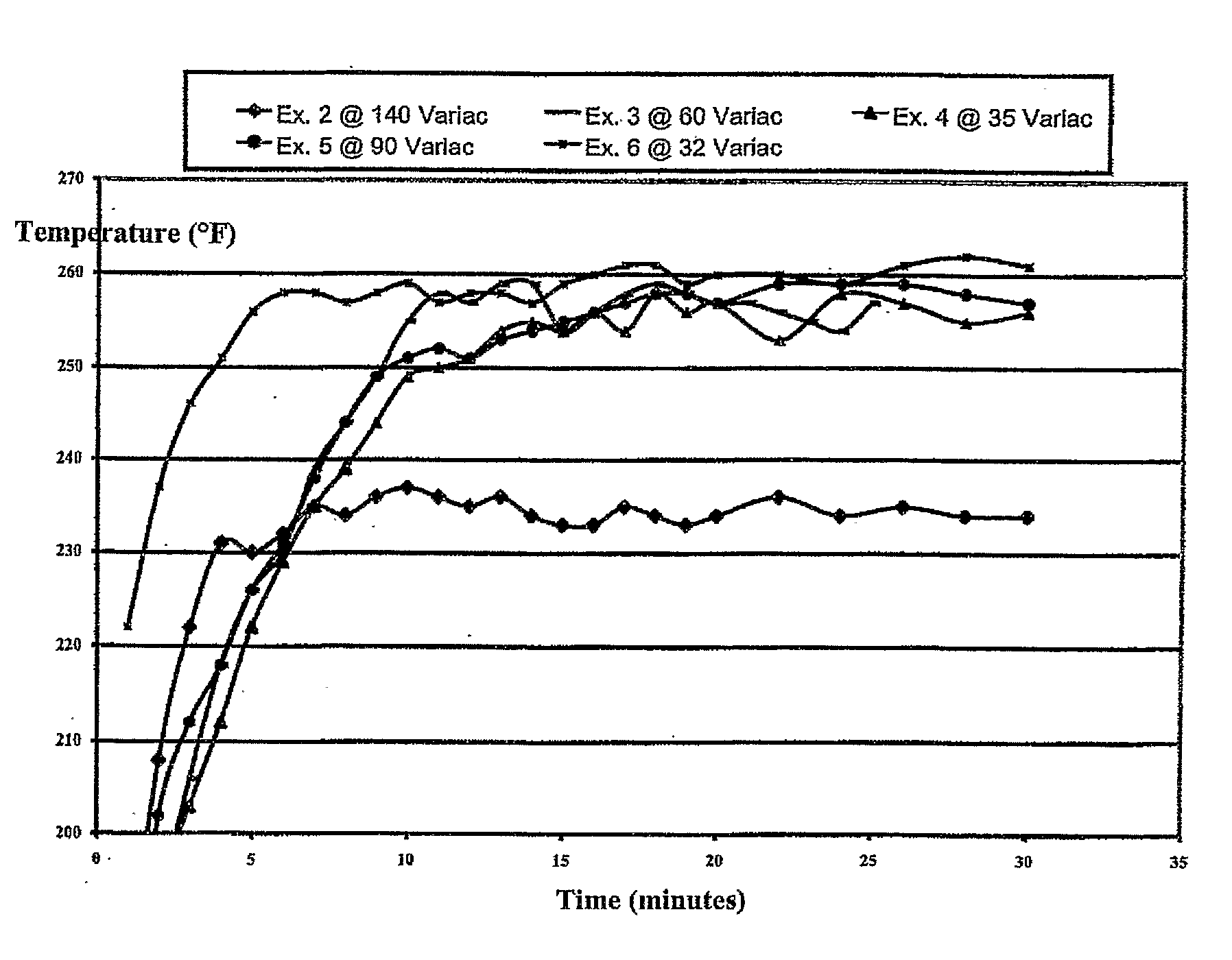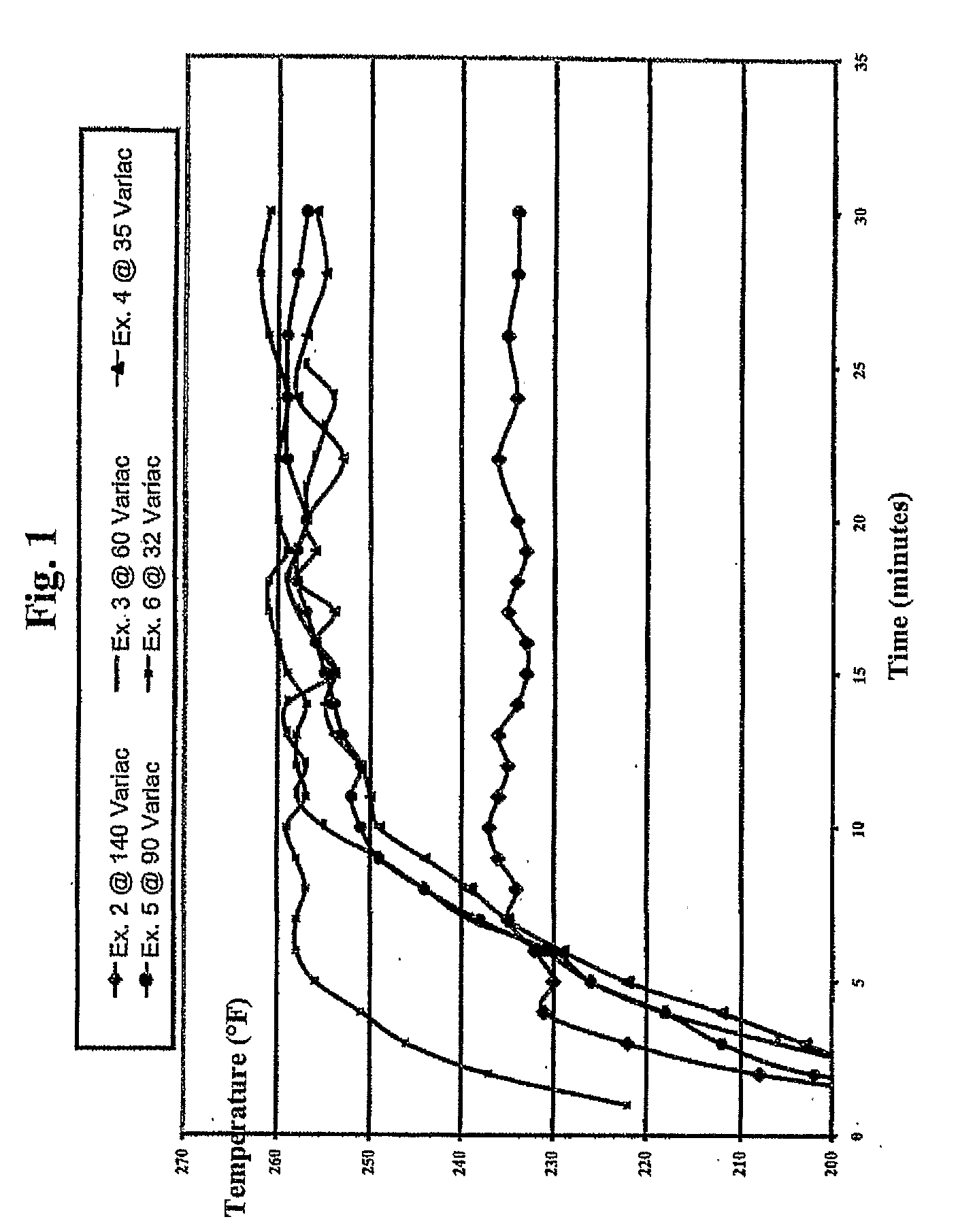Exothermic polyphenylene sulfide compounds
a polyphenylene sulfide and exothermic technology, applied in the direction of non-metal conductors, conductors, organic conductors, etc., can solve the problem of untreated articles, and achieve the effect of avoiding the possibility of thermal conductivity loss
- Summary
- Abstract
- Description
- Claims
- Application Information
AI Technical Summary
Benefits of technology
Problems solved by technology
Method used
Image
Examples
example 1
[0057]Samples of compounds of the present invention were compounded, extruded, and molded into test plaques. All samples were composed of 82.5 weight percent Ryton brand PPS, 12.25 weight percent Printex XE2 brand carbon black particles, and 5.25 weight percent Superior Graphite No. 2939 brand graphite particles, from a production run totaling 50 pounds.
[0058]The carbon black was dry-mixed in a Henschel mixer for about 3 minutes followed by addition of PPS and mixing for about 4 minutes, followed by addition of the graphite and continued mixing for about 6 minutes. Then the dry-blend of the compound was introduced into a Century 30 extruder, with the settings and results shown in Table 1.
TABLE 1Extruder ConditionsSetReadZone 1 (° F.)680408Zone 2 (° F.)680552Zone 3 (° F.)680678Zone 4 (° F.)680706Zone 5 (° F.)680678Zone 6 (° F.)670668Zone 7 (° F.)670669Zone 8 (° F.)670666Zone 9 (° F.)670664Die 2 (° F.)690690Die 1 (° F.)690690RPM / Side screw RPM400X% Torque24%Melt PressX28Melt Temp (° F...
examples 2-6
[0064]Table 5 shows the formulations of Examples 2-6, which are the same as Example 1 except that HDPE is added to improve resistance to brittleness of a final molded part made from the compound. The same compounding and molding conditions were used for Examples 2-6 as were used for Example 1.
TABLE 5FormulationsExam-Exam-Exam-Exam-Exam-Ingredient (Wt. %)ple 2ple 3ple 4ple 5ple 6PPS (Ryton)66.066.066.074.2566.0Carbon Black (Printex4.27.09.84.72510.0XE2)Graphite (Superior9.87.04.211.0254.4Graphite Pigment No.2939)HDPE Powder (Solvay20.020.020.010.020.0No. R21-281)Total Carbon Content in14%14%14%15.75%14.4%CompoundPercentage Carbon Black30%50%70%30%69%to Total Carbon ContentRatio of Carbon Black to0.43:11:12.33:10.43:12.27:1Graphite
[0065]Table 6 shows the results at stated Variac settings.
TABLE 6Temperature DataVariac Setting140 V60 V35 V90 V32 VExample23456TimeTempTempTempTempTemp(min.)(° F.)(° F.)(° F.)(° F.)(° F.)1183186162.7172.52222208192.6192.5202237322220620321224642312182122182...
PUM
| Property | Measurement | Unit |
|---|---|---|
| aspect ratio | aaaaa | aaaaa |
| particle size | aaaaa | aaaaa |
| particle size | aaaaa | aaaaa |
Abstract
Description
Claims
Application Information
 Login to View More
Login to View More - R&D
- Intellectual Property
- Life Sciences
- Materials
- Tech Scout
- Unparalleled Data Quality
- Higher Quality Content
- 60% Fewer Hallucinations
Browse by: Latest US Patents, China's latest patents, Technical Efficacy Thesaurus, Application Domain, Technology Topic, Popular Technical Reports.
© 2025 PatSnap. All rights reserved.Legal|Privacy policy|Modern Slavery Act Transparency Statement|Sitemap|About US| Contact US: help@patsnap.com


